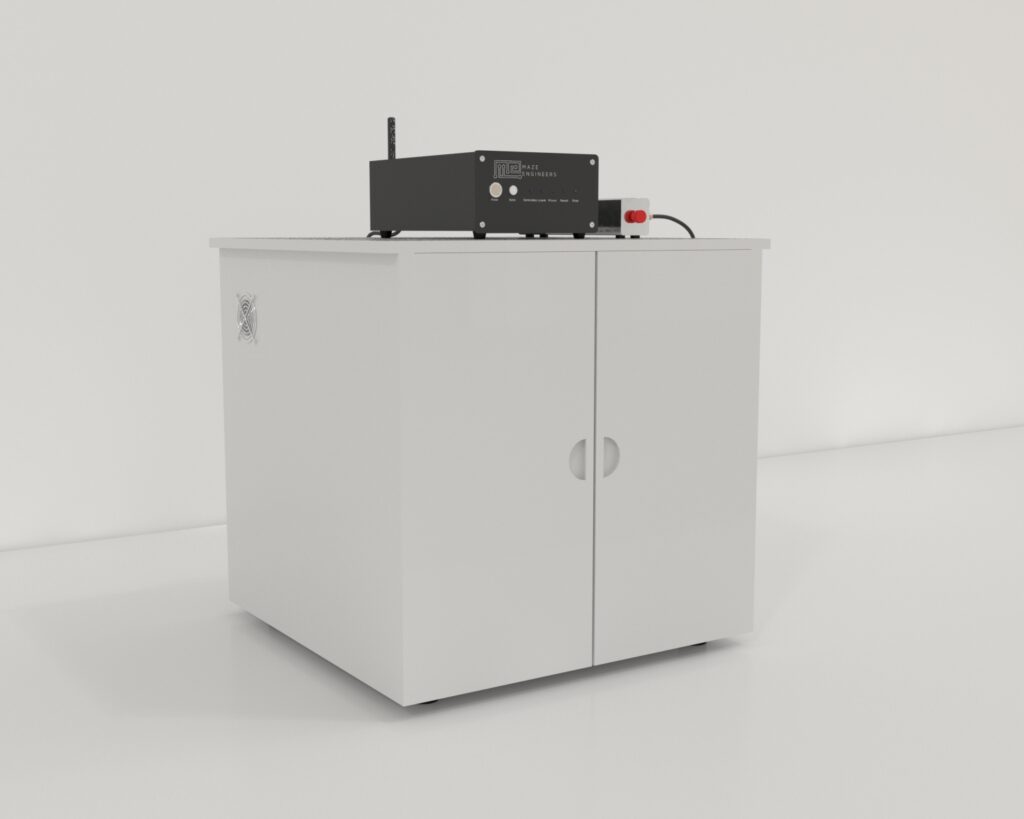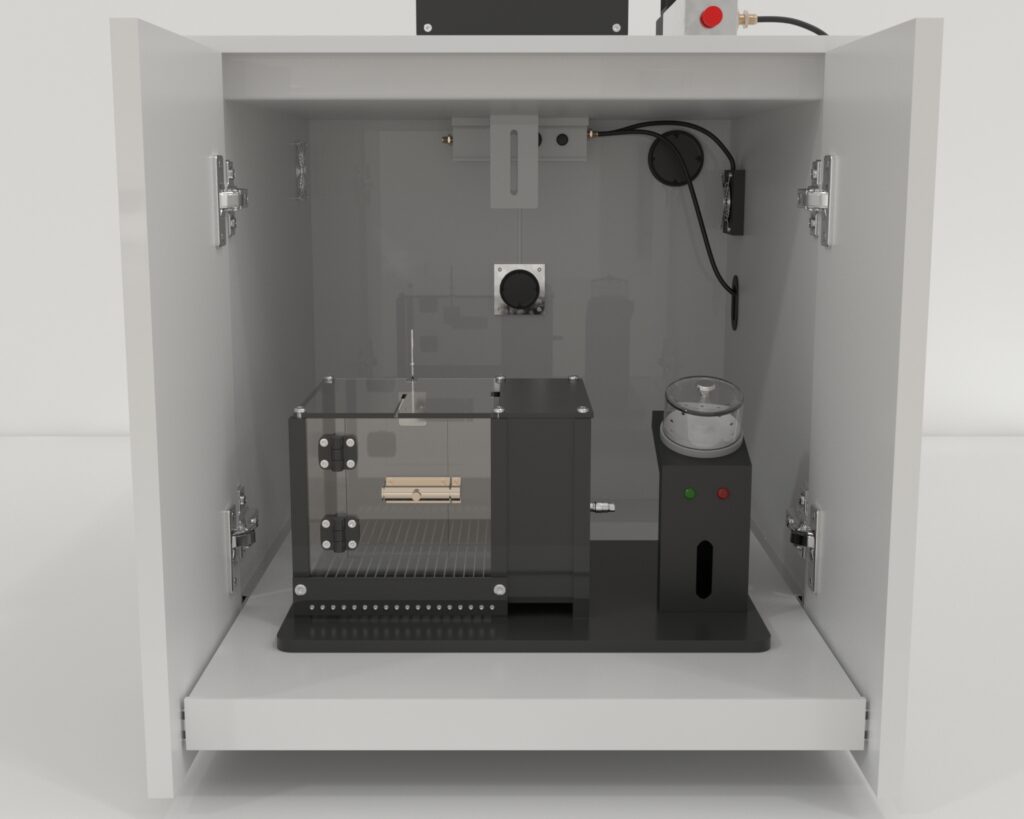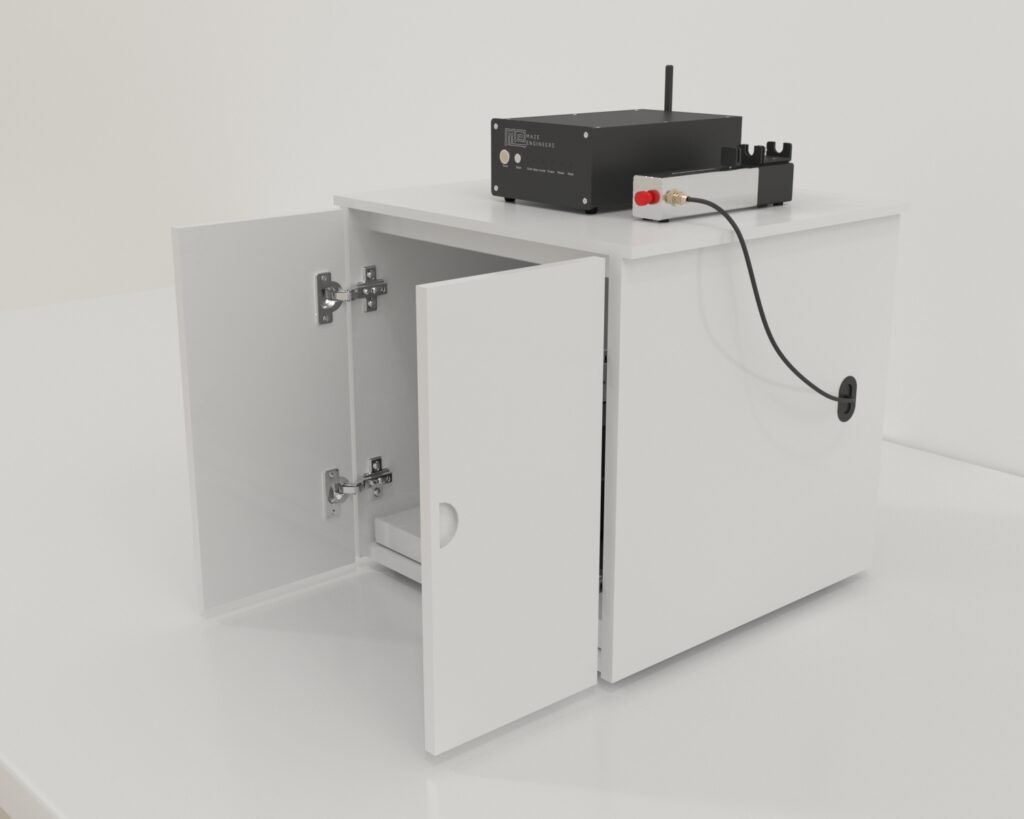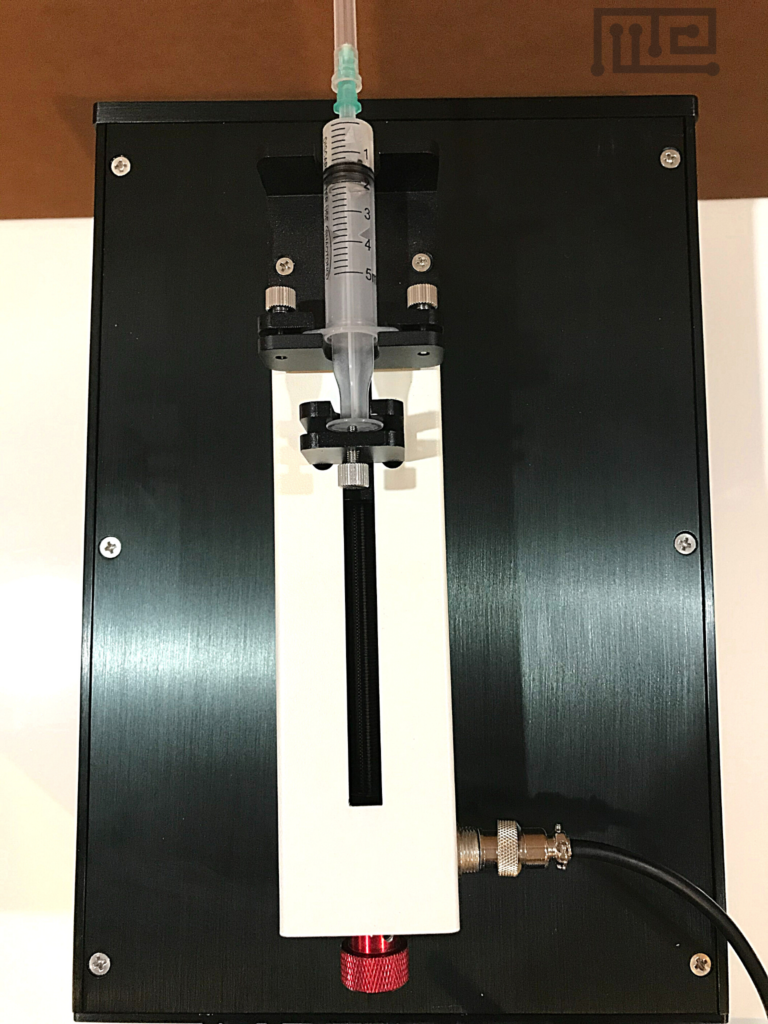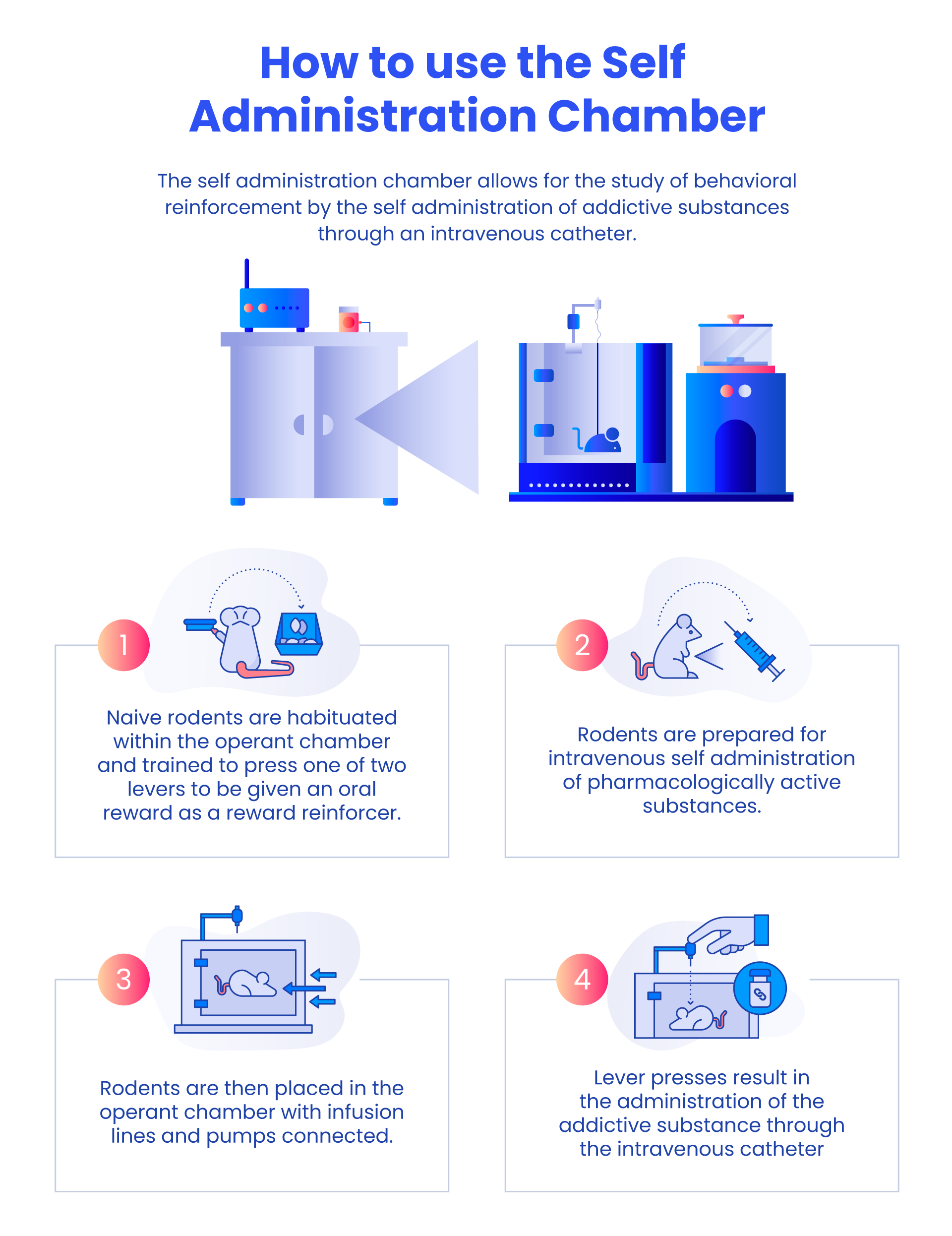Description
The self-administration chamber is used to assess reward-seeking and addiction behaviors. Our chamber offers everything needed for operant-lead self-administration assessments associated with food restriction and intravenous compound administration. Data analysis which can be performed with the self-administration chamber include:
- Number of infusions
- Number of active lever presses/nose-pokes
- Number of inactive lever presses/nose-pokes
Maze Engineers offers the self-administration chamber for mice or rats with dimensions of 18cm (l) x 18cm (w) x 20cm (h) for mice and 26cm (l) x 26cm (w) x 25cm (h) for rats respectively.
Our chamber comes with a sound-attenuating cubicle with light/fan, a syringe pump system, a cage with two portlights and retractable levers, a shock floor grid, and two pellet receptacles. The option for an optic sensor to detect nose pokes can be added.
MazeEngineers offers the Self Administration Chamber.
Price & Dimensions
Mouse
$ 7890
Per Month- Single chamber size: 18cm (l) x 18cm (w) x 20cm (h)
- (2) Levers or Nose Pokes
- (2) LED visual stimuli
- (1) Shock Grid
- (2) Pellet Receptacles
- (2) Pellet Dispenser
- (1) Syringe pump system
- Feces and urine tray
- Isolation cubicle with (1) speaker, (1) house light, (1) circulation fan, (1) IR light after fan
- Conduct Software: $1490
Rat
$ 8190
Per Month- Single chamber size: 26cm (l) x 26cm (w) x 25cm (h)
- (2) Levers or Nose Pokes
- (2) LED visual stimuli
- (1) Shock Grid
- (2) Pellet Receptacles
- (2) Pellet Dispenser
- (1) Syringe pump system
- Feces and urine tray
- Isolation cubicle with (1) speaker, (1) house light, (1) circulation fan, (1) IR light after fan
- Conduct Software: $1490
Social Interaction Self Administration Add-on
$ 990
Per Month- For studying operant social reward and addiction vulnerability
- Separate social chamber connected to the main self-administration chamber
- Automated Door
Take advantage of Neuralynx, Ethovision Integration, SMS and Email integration with the Conductor Science Software. No I/O Boxes Required
Features
Key Hardware Components
- Up to 16 isolation cubicles (sound-attenuating chambers)
- Up to 16 Self-Administration chambers
- Up to 16 chamber control boxes
- One main controller
- Simple and easy wire connections like pull-out floors
- Latest new technologies like wireless connections
Isolation Cubicle Components
- Dimensions 60 x 55 x 65 cm (width x depth x height)
- Multi-layer sound-proof insulation material that attenuates environment disturbance
- LED house light (manual)
- Automated ambient light
- Automated IR light
- Automated air circulation fan
- Cameral holder
- Pull-out floor shelf
Self-Administration Chamber Components
- Mouse chamber
- Two nose poke apertures
- Two cue lights in the apertures
- One pellet dispenser
- Infusion pump
- Frequency tone
- Shock grid
- Shocker (optional)
Mouse Chamber
- The chamber is made of aluminum frame and acrylic walls
- Interaction panel color: default black; other colors is also available per user request
- Other sidewall colors: clear
- Chamber interior dimension (custom dimensions are available):
- Mouse – 18 x 18 x 20 cm (width x depth x height)
- Rat – 26 x 26 x 25 cm (width x depth x height)
- Removable grid floor
- Mouse rod diameter: 4mm, spacing 5 mm
- Rat rod diameter: 6mm, spacing 10mm
- The look & feel is like the pictures. The chamber control box is outside of the cubicle to eliminate the power light inside the cubicle
Two Levers
- Two levers are made of stainless steel and mounted on the interaction panel
- Width: 1.6 cm for rats and 1 cm for mice
Two Nose-poke Apertures
- Two nose poke apertures are mounted on the interaction panel, 1 cm above the floor
- Nose poke aperture dimension: 1.3 x 1.2 x 1.2 cm width x height x depth
- Each aperture is equipped with an infrared sensor capable of detecting the insertion of the animal’s nose
- Nose poke behaviors are used to determine the infusion reward or pellet reward
Two Cue Lights
- Each aperture is equipped with a cue light of configurable colors (white, red, green or blue)
- The light on/off is controlled by the program
Pellet Dispenser
- The pellet dispenser is controllable by the program. It delivers a pellet to the food receptacle given a certain condition. The sensor on the receptacle detects animal nose pokes for food.
- 20 mg pellet dispenser is the default choice (tested with pellets from Bio-Serv).
- 45 mg pellet dispenser is also available
Intravenous (IV) Compound Infusion
- Syringe pump interior diameter 12 mm
- Configurable pump speeds 0.5 – 60 RPM
- Configurable single infusion and maximum infusion amount
- Vascular access harness
- Tether kit for mouse
- Most infusion parts are from Instech Laboratories
Frequency tone
- A speaker per chamber
- Frequency tone – 100-20,000Hz frequency; volume 1-130dB
- Independent sound frequency and volume control for each chamber
Shocker (optional)
- Shock current from 0.1 to 4.0 mA in 0.1 mA steps, programmable control
- “Start/stop“ is controlled by software or manually
Control boxes
- Each chamber unit has one control box that controls the operations of the corresponding self-administration chamber.
Main controller
- Up to 16 control boxes – each self-administration chamber has one control box that controls its operations
- The main controller connects to up to 16 chamber control boxes via wireless communication. The wireless eliminates many cable connections between the main controller and all (up to 16) chamber control boxes
- The main controller connects to the PC via a USB (RS-232) cable and communicates with Maze Engineers Self-Administration software (Conduct Self-Administration) on the PC
Software Implementation
- The Conduct Self-Administration software is used to configure and run experiments
- The software allows the protocol setting per chamber or per group so that both control and treatment groups can be tested simultaneously with the same or different parameters.
- The software supports up to 16 chambers simultaneously
- The software allows chambers to start/stop and run independently
- Have implemented many reward models including the probability model
- Collaborate closely with the user on software enhancements
Frequently Asked Questions
Is there an instruction manual with protocols for the Self Administration Chamber?
Yes, there is a User Manual for the Self-Administration Chamber.
Does the software come with the Self Administration Chamber?
The software comes with the hardware system. The system is a complete system so you can run it when you receive it. The hardware components are detailed in the hardware manual.
Documentation
Introduction
The Self-Administration Chamber is an operant behavioral assay popular in assessing reward-seeking and addiction behaviors (see also Self-Administration Runway). Substance abuse and addiction studies in humans are often based on empirical research (for digital healthcare tools visit ConductScience Digital Health), which does not provide a complete understanding of the underlying mechanisms and factors leading to these behaviors. Animal studies of self-administration, allow overcoming the ethical hurdles and also minimize the effect of individual differences associated with human studies.
The transition to substance addiction, in previously voluntary users, is a developmental-learning association taking place at the neural levels similar to behaviors associated with highly motivated reward-seeking (Everitt, & Robbins, 2005; Lewis, 2017). The Self-Administration Chamber task allows the investigation of instrumental reinforcers in promoting substance taking and seeking behaviors. The chamber consists of a simple set-up of levers and light cues along with the optional reward dispenser (in addition to the reinforcers) placed in a sound-attenuated cubicle. The subject is trained to associate lever press with substance administration, which is then used to evaluate the reinforcing effects of compounds. While the development of substance addiction has a neural basis, other factors such as social pressure and influence (Piña, Namba, Leyrer-Jackson, Cabrera-Brown, & Gipson, 2018) and comorbidity of mental illnesses (Volkow, 2001) also contribute to substance abuse. Social influences can be assessed using multiple Self-Administration Chambers, while mental illness paradigms can be achieved by combining mental illness models. The Self-Administration Chamber also comes equipped with electrified grid flooring which can be used to combine fear-learning protocols with self-administration tasks (see also Fear-Conditioning Chamber).
Automation of the protocols can be achieved using the Conductor Software. Other rodent operant assays include the IDED Operant Chamber, Attentional Set Shifting (IDED) Chamber, and Operant Conditioning Chamber (see Operant Chamber Packages).
Apparatus and Equipment
The Self-Administration Chamber is an acrylic chamber with an overall dimension of 26 × 26 × 30 cm (mouse model has a dimension of 18 × 17 × 25 cm). The side walls are made of clear acrylic, while the remaining two walls are made of aluminum. The chamber comes with pairs of portlight (available in yellow, red, or green light) and retractable levers. The pellet/liquid receptacle (pellet dispenser or lick-o-meters) is placed in between the levers. The option to include an optic sensor to detect nose pokes is also available. The chamber also comes equipped with a removable electric grid floor and a removable feces and urine tray for easy cleaning. The grid flooring has rods having a diameter 6 mm and a spacing of 5 mm (the model has the diameter of a rod 4 mm and spacing 5 mm), and the shock intensity can be varied between 0.1 to 4 mA in 0.1 mA steps. The shock generator is placed outside the chamber. The chamber is placed within a sound-attenuating chamber (50 × 40 × 40 cm) that comes equipped with a speaker, a house light, a circulation fan, and a syringe pump system. The syringe pump system consists of a variable speed syringe pump, vascular access harness, and a tether kit for the animal.
Training Protocol
Clean the apparatus and the testing chamber prior to beginning the sessions and in between trials to prevent the influence of any lingering stimuli on the performances. Multiple animals can be tested at a time. However, testing conditions should be maintained for the groups throughout the sessions. The Self-Administration Chamber task requires food or liquid restrictions before sessions to motivate the subjects to complete the task.
Self-Administration Chamber task protocols vary depending on the requirements of the investigation. The following are the common approaches to the task (Thomsen, & Caine, 2005)
- Food restricted animals are initially trained with food rewards and then with the intravenous compound administration as a reinforcer in the absence of food reward.
- Food restricted animals are initially trained with food rewards and then with the intravenous compound administration as a reinforcer with food freely available.
- Animals are directly trained using intravenous compound reinforcement without any prior operant training.
Following is a sample protocol for self-administration tasks using a lever manipulandum.
Food-Shaping Trials
Following familiarization with experimenter handling and the testing room, place the subject in the Self-Administration Chamber. Begin training the subject to press the lever on a fixed ratio 1 schedule using the food reinforcers. Perform one session for one hour or until 20 reinforcements have been consumed daily. Repeat trials on a fixed ratio 2 schedules. Conclude food-shaping trials when the subject achieves stable response criterion on either lever for both schedules. Follow the food-shaping trials with catheter placement surgery (for surgical tools click here).
Acquisition and Training Trials
Following the rest period, post-surgery, begin acquisition trials for self-administration on a fixed ratio 1 schedule. Begin each session with a priming injection of the substances. Reinforce each lever press with compound administration accompanied by the flashing of the stimulus light. Follow the lever-press with a time-out (lights turned off) of 30 seconds of no activity or reinforcement. Perform each session for 180 minutes with a preset maximum number of injections. Conclude acquisition trials once the subject meets the predetermined acquisition criteria of minimum self-administration and active-to-inactive lever press ratio over 3 consecutive sessions.
Begin training sessions using a fixed ratio 2 schedule and unlimited reinforcers. Conduct each session for 90 minutes until a stable baseline for substance intake is established across three consecutive sessions.
Dose-Response Test Trials
Conduct test trials similar to the training session, with the exception that the priming dose is the same as the dose being tested. Test each dose independently over consecutive days. End the phase with saline-only trials.
Extinction Trials
Present the subject with both active and inactive levers. However, program both levers to have no consequences when pressed. Observe extinction behaviors for about 30 to 90 minutes.
Relapse-Reinstatement Test Trials
Ideally, relapse-reinstatement sessions should be performed after a forced abstinence period. The following protocol uses three reinstatement induction conditions: conditioned stimuli, stress, and substance infusion.
Follow the extinction trials by a conditioned stimuli-induced reinstatement test in the absence of substance infusion. During the first 30 minutes, present the conditioned stimuli (cue light associated with substance infusion), non-contingently, for 20 seconds. Follow this with another 30 minutes of contingent presentation of the conditioned stimuli (2 seconds) on active lever presses on a fixed ratio 1 schedule. End the phase with a foot shock followed immediately by 30 30-minute periods of observation of nonreinforced responding. Begin the next reinstatement period (30 minutes) with a noncontingent substance infusion.
Data Analysis
The following observations can be made in the Self-Administration Chamber Task,
- Number of infusions
- Number of active lever presses/nose-pokes
- Number of inactive lever presses/nose-pokes
Strengths and Limitations
Strengths
The Self-Administration Chamber can be used with either nose-poke or lever manipulandum. While the nose-poke system is considered more natural for rodents, the use of lever is equally effective. The lever system allows retraction of the levers, which can be helpful during the acquisition phase or non-activity phase. The chamber also allows the opportunity to use either liquid or food rewards. The chamber also comes equipped with a speaker, light, and electric grid flooring, which allows different combinations of conditioning cues. The use of electric grid flooring is useful in evaluating stress and fear-induced reward-seeking or substance abuse behaviors. The chamber assay, unlike the Self-Administration Runway, does not include a locomotory element.
Limitations
Improper post-surgery care can potentially affect self-administration performances. For protocols that require pretraining using appetitive rewards, subjects need to be placed on liquid or food restrictions. Thus, the subject’s appetitive motivation needs to be maintained during trials. Improper handling of the subject can induce stress in the subject, which can, in turn, affect performances. Factors such as age, strain, species, and sex can also impact performances. Changes in the context or food reward may affect performances.
Summary
- The Self-Administration Chamber is an operant chamber used in reward-seeking and abuse research.
- The chamber allows the use of either nose-poke or lever press manipulandum.
- The apparatus comes with an electrified-shock grid that can be used to evaluate stress- or fear-induced substance-seeking. Audio and light cues are also available.
- The task doesn’t involve significant locomotory activity, unlike the Self-Administration Runway.
- Performances in the apparatus may be affected by the animal’s lack of appetitive motivation.


